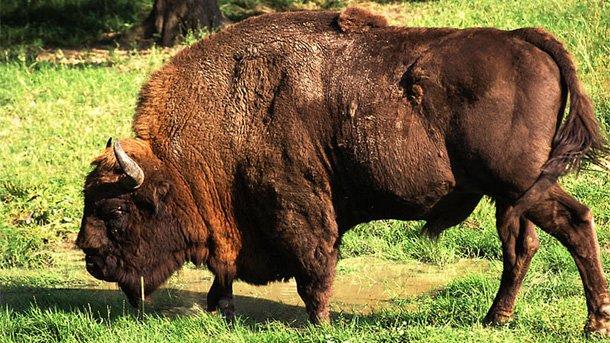
Снимка: Photo: wikipedia.org
A wisent, what was that? How does it look like? Few Europeans will know that, because one can rarely see the European bison nowadays across the Continent. It wasn’t like that not so long ago, Mr. Stefan Avramov from the Bulgarian Biodiversity Foundation /BBF/ says.
These animals get extinct due to unnatural and unexpected enemies – war and starvation.
“Wars are related to periods of instability and poaching levels go sharply up,” the ecology expert explains. “The European auroch could be seen at two spots only in Europe in the beginning of the 20th century. The first is the Bialowieza Forest, today a natural reserve at the border between Poland and Belarus that used to be a huge hunting estate property of the Polish and Russian tsars. The other place consists of several hunting reserves in the Caucasus. However, almost the entire population there was killed after WWI. The last auroch was shot down in 1927, that’s for sure. Different zoos tried to restore these animals’ population afterwards. They managed to increase their number to several hundreds that were again killed during WWII. Practically today we have 3 – 5,000 representatives of the European bison species. There are two kinds – the ones in the Bialowieza Forest and a hybrid with the Caucasian auroch, residing at the Caucasian Biosphere Reserve.”
Practically nowadays the European auroch has no natural enemies, Mr. Avramov points out, which is good for its return.
“The European aurochs lives mainly at open space and needs no big forests, since its food consists of grass species,” the expert says. “It almost doesn’t have any natural enemies, since even the bear and the wolf find it really hard to knock the huge animal down. I would say that’s impossible and the European aurochs, or what’s left of it, is the natural landlord of European forests.”
This animal species was extinct in Bulgaria as early as the Middle Ages. However, a month ago a two-year project kicked off for inhabiting of the European auroch among nature and named The Wild World of East Rhodope. The initiative belongs to the New Thracian Gold /NTG/ foundation, working for the area of the East Rhodope. Being one of the richest in biodiversity regions in Europe, the spot struggles to find its place among the 10 unique European wild territories of global significance within the Rewilding Europe initiative. A couple of years ago the foundation kicked off the displacement of the tarpan wild horse species. Due to 1960s attempts there are few European auroch species representatives with the Voden hunting property in North Bulgaria, but their detailed genealogy has been lost and so the new project opted for 5 pure animals from Germany.
“Bulgaria is the zone where the bison from the Bialowieza – Caucasus line should be restored,” Stefan Avramov says. “Those animals in Voden are of that kind, but they have been written off the International Tribe Book due to the two decades of lack of information. This is a really important issue, since the animals may get sick due to cross breeding with similar blood and may even die. That is why we’d better not take animals from Voden.”
It all won’t be easy, we can figure that out.
“A couple of animals died, most likely because of some illness during the transportation, but the others are adapting really well. We hope for a next generation over the forthcoming years, this small herd will start to increase and will have tourist visits. By the way, it attracted huge interest yet in the first days after its arrival, since it is located next to the Tatul rock tombs. The animals are now surrounded by an electric wire fence and they will spend some more time there, in order to adapt.”
The European auroch fellows are now with the Studen Kladenets hunting property, where later on they will be released as a tourist attraction. We can think of other territories in the future, Mr. Avramov says, for instance the Strandja Natural Park, in case of success here.
English version: Zhivko Stanchev
По публикацията работи: Maria Dimitrova-Pichot
Последвайте ни и в
Google News Showcase, за да научите най-важното от деня!